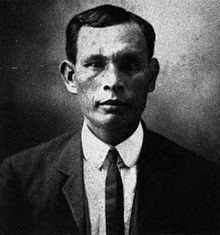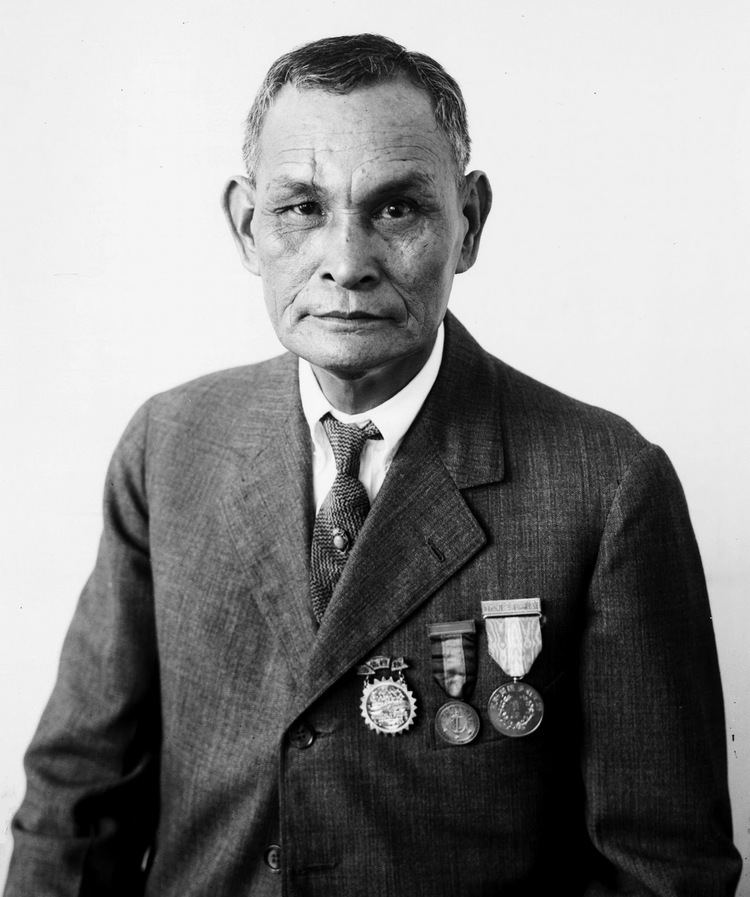Years of service 34 Other names Charlie Chan | Role Police officer Name Chang Apana | |
 | ||
Born December 26, 1871 ( 1871-12-26 ) Waipio, Oahu, Hawaii Died December 8, 1933, Hawaii, United States Similar People Earl Derr Biggers, Warner Oland, Sidney Toler, Kamehameha II, Kekuanaoʻa | ||
Charlie chan chang apana
Apana Chang (December 26, 1871 – December 8, 1933; traditional Chinese: 鄭阿平; simplified Chinese: 郑阿平; pinyin: Zhèng Āpíng; Jyutping: Zen6 Aa3ping4) was a Chinese-Hawaiian member of the Honolulu Police Department, first as an officer, then as a detective. He was acknowledged by Earl Derr Biggers as the inspiration for his fictional Asian detective character, Charlie Chan.
Contents
- Charlie chan chang apana
- Early life
- Police career
- Inspiration for Charlie Chan
- Changs retirement and death
- Influence
- References

Early life

Ah Ping Chang (鄭阿平) was born December 26, 1871 in Waipio, Oahu, Hawaii. (Apana is the Hawaiianized version of the Chinese name Ah Ping.) His family moved back to China when he was 3, but Chang returned at the age of 10 to live with his uncle in Waipio. As an adult, Chang was fluent in Hawaiian, and knew Hawaiian Pidgin (Creole English) and Chinese as well. He never learned to read, relying on his family to read newspapers and documents for him. In his youth, he worked as a paniolo (Hawaiian cowboy), starting in 1891, and it was as part of this job that he first began carrying a bullwhip on a regular basis. Three years later, Chang started working for the Hawaii Humane Society, which at the time was part of the police department on the island. The Humane Society was founded by Helen Kinau Wilder, the owner of the horses that Chang had handled as a paniolo. Wilder was the daughter of shipping magnate Samuel Garner Wilder.
Police career

In 1898, Chang joined the Honolulu Police Department. He was assigned to patrol Chinatown areas referred to as "Blood Town" and "Hell's Half Acre". In his early years as a detective, beginning in 1916, Chang worked on opium-smuggling and illegal gambling cases primarily.

Due in part to his fluency in several languages, his wide network of informants and because of his shrewd and meticulous detective style, Chang was successful in solving many cases. Many stories about Chang's career have arisen. Chang helped round up people infected with leprosy and send them to a leper colony on the island of Molokai. While performing this duty, Chang was attacked by a Japanese leper with a sickle, leaving him with a distinctive scar over his right eye. Another time Chang was thrown out of a second story window by drug addicts only to land on his feet. There is an account that he raised the alarm on a shipment of contraband after being run over by a horse and buggy. One night in Honolulu, with no backup and armed only with his bullwhip, Chang arrested 40 gamblers, whom he then lined up and marched back to the police station.
Inspiration for Charlie Chan
Earl Derr Biggers vacationed in Hawaii in 1919 where he was inspired to begin to write the novel House Without a Key. While reading Honolulu newspapers in the New York library in 1924, he read about the exploits of Apana Chang. Biggers then created a new character based on Chang for his novel, inserting him a quarter of the way through the book. The character became popular and Derr Biggers expanded his presence in his novels.
Chang met actor Warner Oland, who portrayed Charlie Chan, when The Black Camel was filmed in Hawaii. When Biggers met Chang in 1928 the real detective was already being called "Charlie Chan", and Chang enjoyed watching his fictional counterpart's films. After five more novels, Derr Biggers publicly acknowledged Chang as the inspiration for his character in a letter to the Honolulu Advertiser dated June 28, 1932. His widow states, though, that Chan was actually based on Biggers himself, resembling him in physique and character, whereas Chang was slight in build, quick to anger, and involved in very few actual murder cases.
Chang's retirement and death
After 34 years of service, Chang retired in May 1932 as a detective when he was injured in a car accident. He briefly worked as a watchman for the Hawaiian Trust building. On December 2, 1933, Chang was admitted into Queen's Hospital after a month-long period of serious illness. On December 7, 1933, his gangrenous leg was amputated and he died the following day. Chang Apana is buried at the Manoa Chinese cemetery in Honolulu.
Influence
Chang's law enforcement career was an influence on other fictional works other than Charlie Chan. Max Allan Collins's 1996 novel, Damned in Paradise, fictionalizes the famous Massie case. Collins included fictionalized depictions of several historical figures, including Chang Apana, who was an active-duty detective at the time of the Massie case (though there's no official record of Chang being one of the investigating officers).
Usagi Yojimbo, a comic book series by Stan Sakai that is set in 17th century Japan and features a cast of anthropomorphic characters, includes occasional appearances of a character named Inspector Ishida who is partially based on Chang Apana. As Max Allan Collins points out in the introduction to Usagi Yojimbo Book 13: Grey Shadows, Inspector Ishida is, like the real Chang Apana, a more hardboiled character than the mild-mannered Charlie Chan .
A character based on Chang Apana also interacts with fictional characters in Allan Brennert's 2010 work of fiction, "Honolulu."
In a 2011 comic story written by Mike Curtis and illustrated by Joe Staton for the Dick Tracy newspaper strip, Tracy's friend and colleague, HPD officer Haku Kou, is depicted as being the technical advisor on a movie being filmed in Tracy's city because of the title character's facility with a blacksnake whip. Kou explains that he became proficient with that weapon (leading to his being hired as the film's technical advisor) in emulation of Chang Apana.
